Ohio held two Congressional Special Election primaries on Tuesday, August 3rd. Both the Democratic primary in OH-11 and the Republican primary in OH-15 were competitive contests. There were no consequences to waging factional battles of influence and supremacy because both seats are safe for their respective parties. Congressional Black Caucus-endorsed (CBC) County Councilor Shontel Brown defeated Progressive icon Nina Turner in the OH-11 Democratic primary. Former President Trump’s handpicked Republican candidate, coal lobbyist Mike Carey, defeated ten other Ohio Republicans to win the Republican primary in OH-15.
OH-11 and the Democrats
Then-President-Elect Biden announced in 2020 he intended to nominate OH-11 Representative Marcia Fudge as Secretary for Housing and Urban Development. Both Biden and Fudge won OH-11 with approximately 80% of the vote, meaning that the Democratic primary effectively decided who would represent the district. Voter support initially congregated around Nina Turner, a former Ohio Legislator better known for her work in Bernie Sanders’ Presidential campaigns and Our Revolution. National CBC politicians including Congressman Jim Clyburn rallied around Shontel Brown in response to Turner’s perceived electoral strength, boosting her profile.
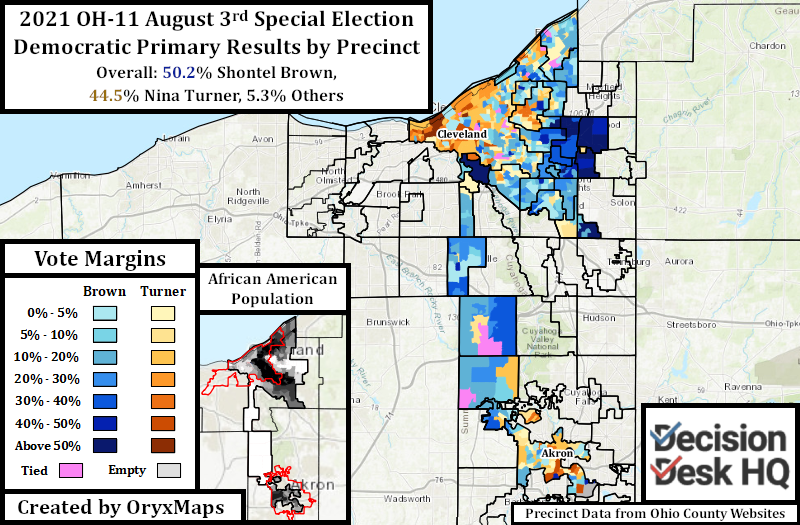
Shontel Brown won with 50.2% of the vote, or 37,666 votes, to Nina Turner’s 44.5% and 33,420 votes. Brown won Cuyahoga County (Cleveland) home to approximately 90% of primary voters by 6%. Turner won the much smaller Summit County (Akron) portion of the district by less than one percent.
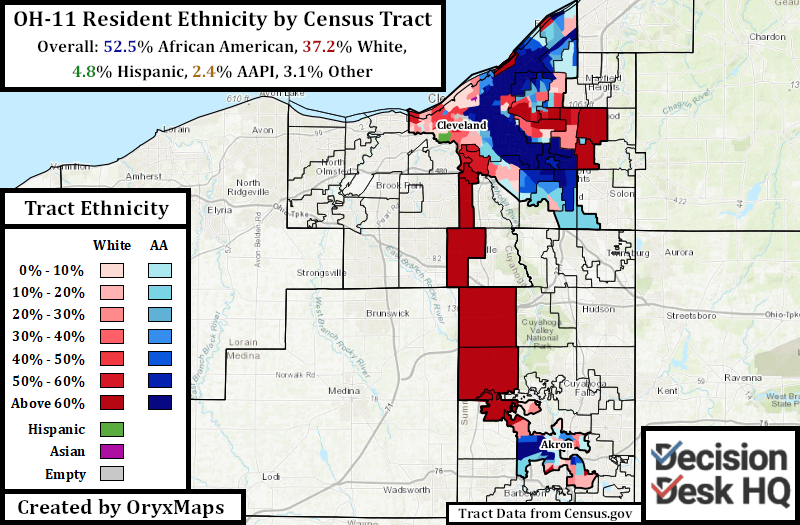
OH-11 is a majority-minority African American district. All community demographics break down along ethnic lines. The African-American population in and around both Cleveland and Akron lag their White neighbors in the oft-cited demographic indicators of educational attainment and household income, among many other statistics. Over a century of local policies birthed this stark contrast, from redlining in the 1930s and 40s to industrial decline in the 1970s and 80s.
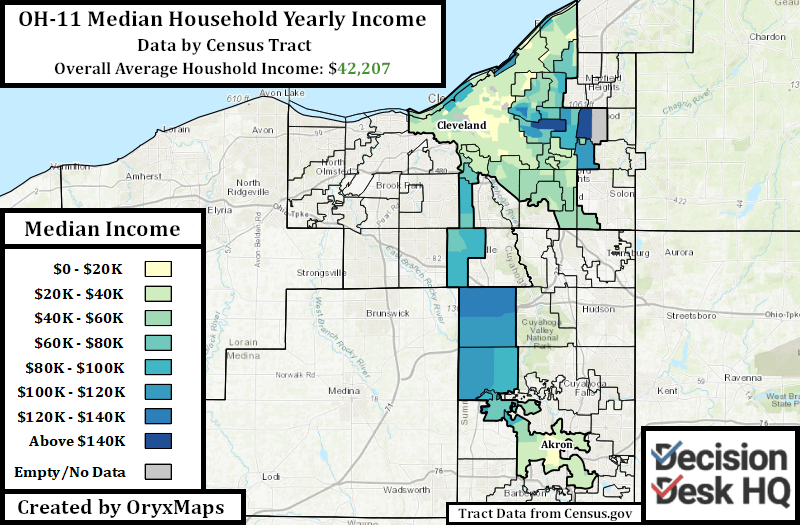
The election however did not fall clearly along this broad demographic divide. Brown won both African American and White voters districtwide. She did slightly overperform with White voters, but neither major demographic group overwhelmingly favored one candidate and denied victory for the other.

Instead, smaller and localized groupings of voters within the district explain the distribution of electoral coalitions. Turner did better in the urban sections of both cities regardless of race, with Brown doing better in the suburbs. Brown dominated with non-African American suburbanites, most notably in Shaker Heights and other east Cuyahoga communities. Some of these communities have large Jewish populations and most are part of Brown’s Council district.

Turner’s best performing were Downtown Cleveland and western neighborhoods like Ohio City. These areas comparatively lack significant urban African Americans communities and are younger, gentrifying, and the focus of urban renewal projects. The most heavily African American and economically depressed areas in both cities had some of Brown’s best urban precincts, but Turner won more urban African American precincts overall.
Shontel Brown faces Republican Laverne Gore in the November Special Election. The overwhelming Democratic composition of the electorate near-guarantees that Brown is the next representative for OH-11.
OH-15 and the Republicans
Incumbent Republican Congressman Steve Stivers announced in April that he would resign from Congress on May 16th and assume leadership over the Ohio Chamber of Commerce. This vacancy opened up a seat former President Trump won with 56% to Joe Biden’s 42%, and therefore attracted numerous prominent Ohio Republicans.
Former President Trump endorsed coal lobbyist Mike Carey to succeed Stivers in OH-15, notably stating that he “doesn’t even know who the others are.” Trump however was not the only prominent Republican backing a potential candidate. Stivers and Ohio Legislators backed fellow State Representative Mike LaRe, local Republican organizers backed State Senator Bob Peterson, Rand Paul and other Libertarians backed former State Representative Ron Hood, and Mark Meadows’ wife lined up her husbands’ allies in support of former Columbus NAACP President and faith-based organizer Ruth Edmunds. Other prominent candidates included suburban Columbus State Senator Stephanie Kunze and self-funded golf course owner, Thomas Hwang.
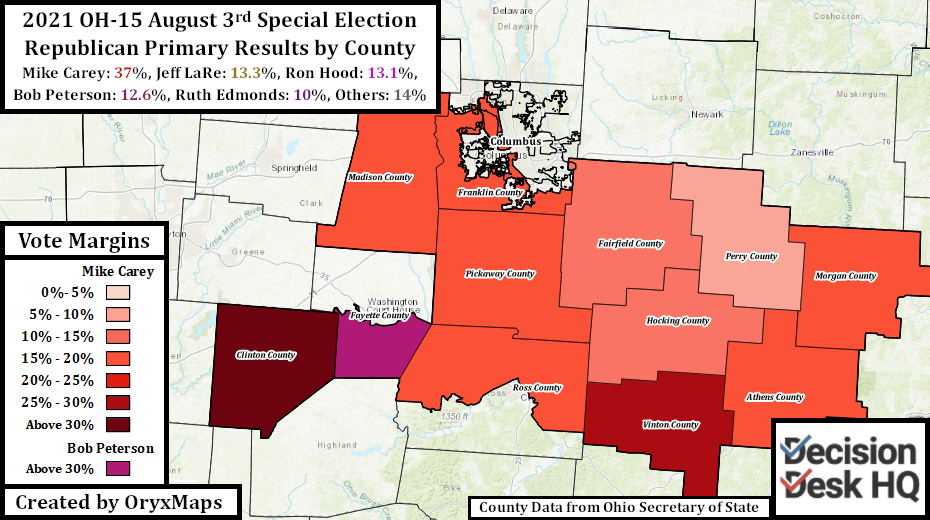
Mike Carey triumphed over the divided Republican field. Carey won 18.6K votes and 37% of the vote – 12K votes more than his nearest opponent. LaRe, Hood, and Peterson each had their own legislative bases of support and divided Carey’s opposition. They won 13.3%, 13.1%, and 12.6% of the vote respectively. Carey won eleven of the twelve counties within the district, and his plurality victory allowed him to win almost every precinct in the district.
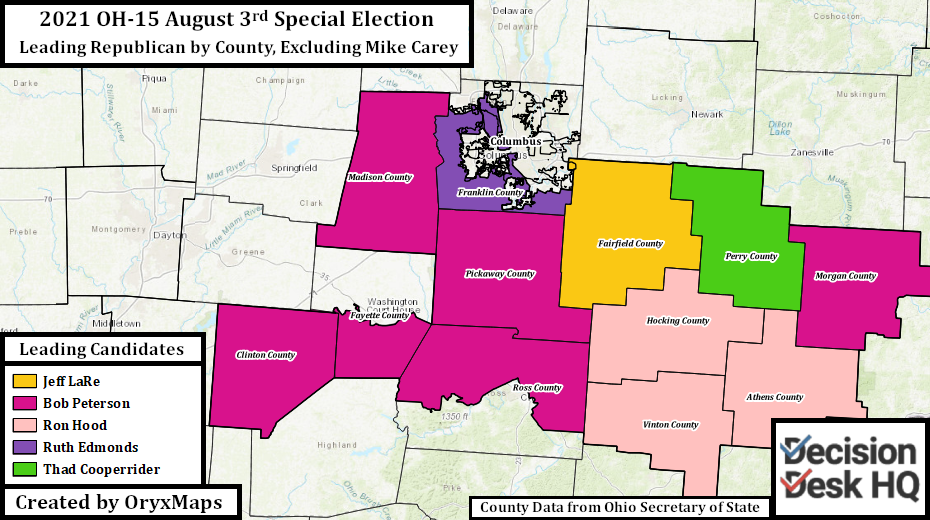
Removing the dominant Carey from the analyzed results reveals division within his opposition. LaRe came in second in his home county of Fairfield that he represents in the legislature. Hood and Peterson divided the rural vote largely along the lines of their legislative districts, with the exception of Morgan County where Peterson finished one vote ahead of Hood. Edmonds finished second in Franklin, and a minor candidate, Thad Cooperrider, finished behind Carey in Perry County. Nearly all of Kunze’s support came from her district in Franklin County, though she only finished fourth place in the county overall. These strongholds of support meant that Carey could unite a dispersed coalition and win with a plurality.
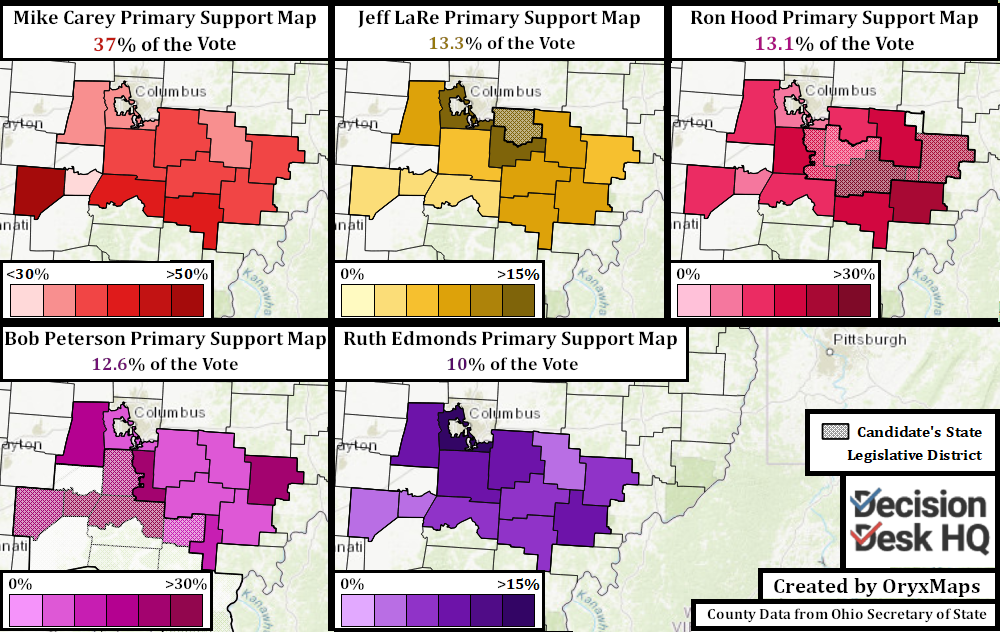
Mike Carey faces Democratic State Representative Allison Russo to win election to Congress in November. Russo flipped a suburban Franklin County seat outside of Columbus in 2018 and held the district in 2020. Mike Carey starts as the overwhelming favorite to hold this conservative district for Republicans, but Democratic Columbus and Athens could give Russo victory if everything goes perfectly.
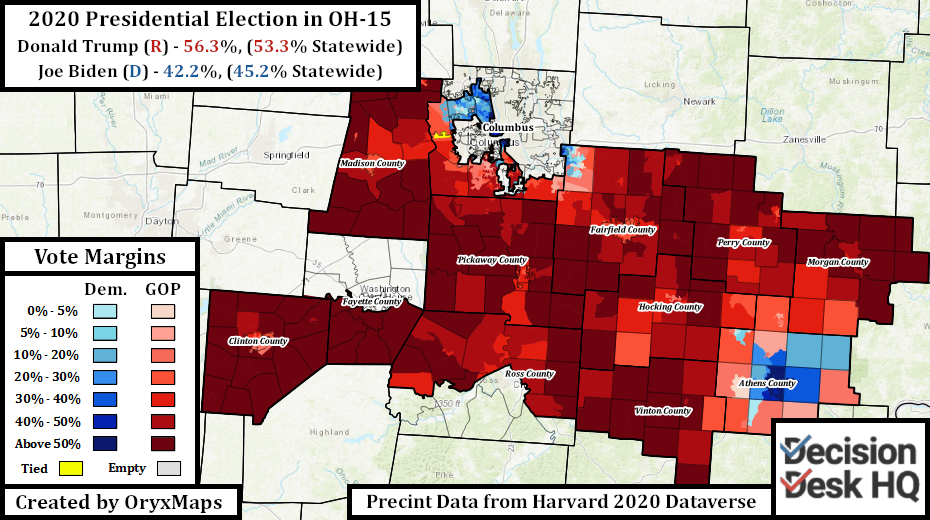
Ben Lefkowitz (@OryxMaps) is a Contributor to Decision Desk HQ.